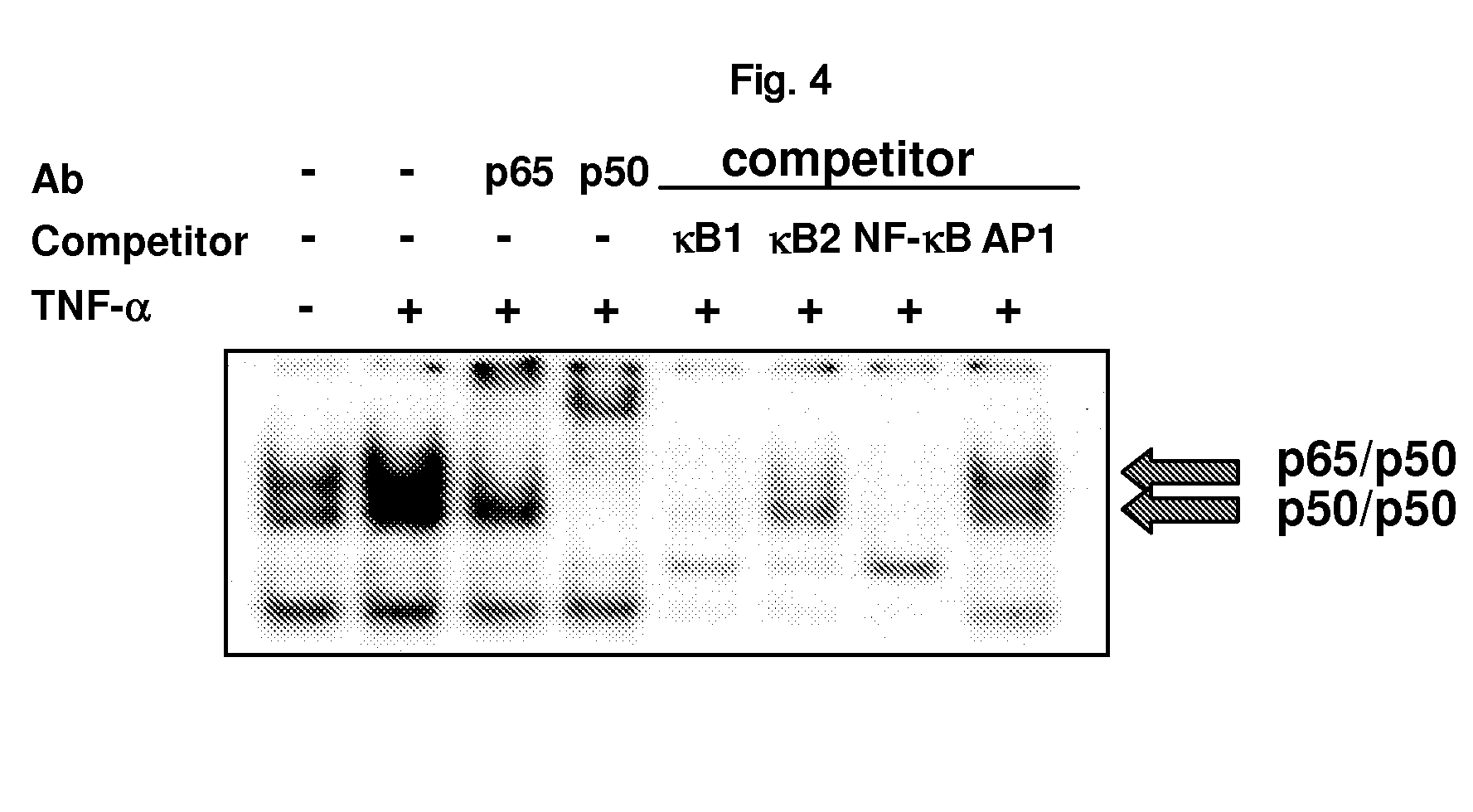Therapeutic agent for cancer, inflammation, and auto-immune disease containing inhibitor of zinc finger protein 91
a technology of zinc finger protein and inflammatory disease, which is applied in the field of cancer, inflammation and autoimmune diseases containing inhibitors of zinc finger protein 91, can solve the problems of cancer cells that cannot be proliferated without, its functions and roles in cancer cells are not, and can not be effectively used for cancer treatment, etc., to achieve the effect of increasing the expression of apoptosis inhibiting proteins and increasing the expression of proteins regulating cell cycl
- Summary
- Abstract
- Description
- Claims
- Application Information
AI Technical Summary
Benefits of technology
Problems solved by technology
Method used
Image
Examples
example 1
Screening of NF-κB Target Genes Using cDNA Microarray
[0173]As an effort to find the intracellular effector of the NF-κB inhibitor KA (kamebakaurin), cDNA microarray (Eisen M B & Brown P O, Methods Enzymol 303, 179-205, 1999) was performed to screen a gene regulated by KA. A human breast cancer cell line MDA-MB-231 cells were treated with DMSO and kamebakaurin (10 μg / ml) respectively, followed by culture for 5 hours. The cells were washed with cold PBS three times. The total RNA was extracted by using RNeasy Mini kits (Qiagen, Santa Clarita, Calif., USA), followed by 17K human cDNA microarray performed by GenomicTree Co. (KR). As a result, 333 genes up-regulated in the human breast cancer cell line MDA-MB-231 cells and 295 genes down-regulated therein were screened. To re-confirm that cDNA expression was suppressed by KA, RT-PCR with 50 genes selected among them was performed as follows.
example 2
Selection of Target Gene Candidates of Kamebakaurin by RT-PCR and Northern Blotting
[0174]A human breast cancer cell line MDA-MB-231 cells was treated with DMSO and kamebakaurin (10 μg / ml) respectively, followed by culture for 5 hours. The cells were washed with cold PBS three times, and then total RNA was extracted by using RNeasy Mini kits (Qiagen, Santa Clarita, Calif., USA) 5 μg of the total RNA was used for the synthesis of cDNA using Invitrogen kit Access RT-PCR Kit (Promega, Madison, Wis., U.S.A.). The ZFP91 specific primer was constructed based on the nucleotide sequence of Genebank (Accession No. NM-053023). Each candidate gene specific primer was constructed based on the informed nucleotide sequences (Table 1). PCR was performed with prepared cDNA as follows: predenaturation at 95° C. for 5 minutes, denaturation at 94° C. for 1 minute, annealing at 50° C.-60° C. for 2 minutes, polymerization at 70° C. for 1 minute, 30 cycles from denaturation to polymerization. The gene-spe...
example 3
Analysis of Amino Acid Sequence and Motif Promoter Region of ZFP91
[0178]ZFP91 was confirmed to be composed of 570 amino acids and expected size of this protein was about 63 kDa (actual size in cell was confirmed to be 91 kDa; Unoki et al., Int J Oncol 22, 1217-1223, 2003). It was confirmed from the data analysis on ZFP91 that ZFP91 has 5 Zinc finger domains, one coiled coil, and leucine zipper pattern. Its 5′ region analysis revealed two NF-κB consensus sequences in −1105 and −1664 regions of 5′ upstream region (Ensembl Genome Browser; http: / / www.ensembl.org, MOTIF: Searching Protein and Nucleic Acid Sequence Motifs; http: / / motif.genome.ad.jp). It was also presumed to have four nuclear localization sequences and 87% was the chance of being in nucleus (TargetP Server v1.01; http: / / www.cbs.dtu.dk / services / TargetP) (FIG. 3).
PUM
| Property | Measurement | Unit |
|---|---|---|
| concentration | aaaaa | aaaaa |
| concentration | aaaaa | aaaaa |
| concentration | aaaaa | aaaaa |
Abstract
Description
Claims
Application Information
 Login to View More
Login to View More - R&D
- Intellectual Property
- Life Sciences
- Materials
- Tech Scout
- Unparalleled Data Quality
- Higher Quality Content
- 60% Fewer Hallucinations
Browse by: Latest US Patents, China's latest patents, Technical Efficacy Thesaurus, Application Domain, Technology Topic, Popular Technical Reports.
© 2025 PatSnap. All rights reserved.Legal|Privacy policy|Modern Slavery Act Transparency Statement|Sitemap|About US| Contact US: help@patsnap.com



